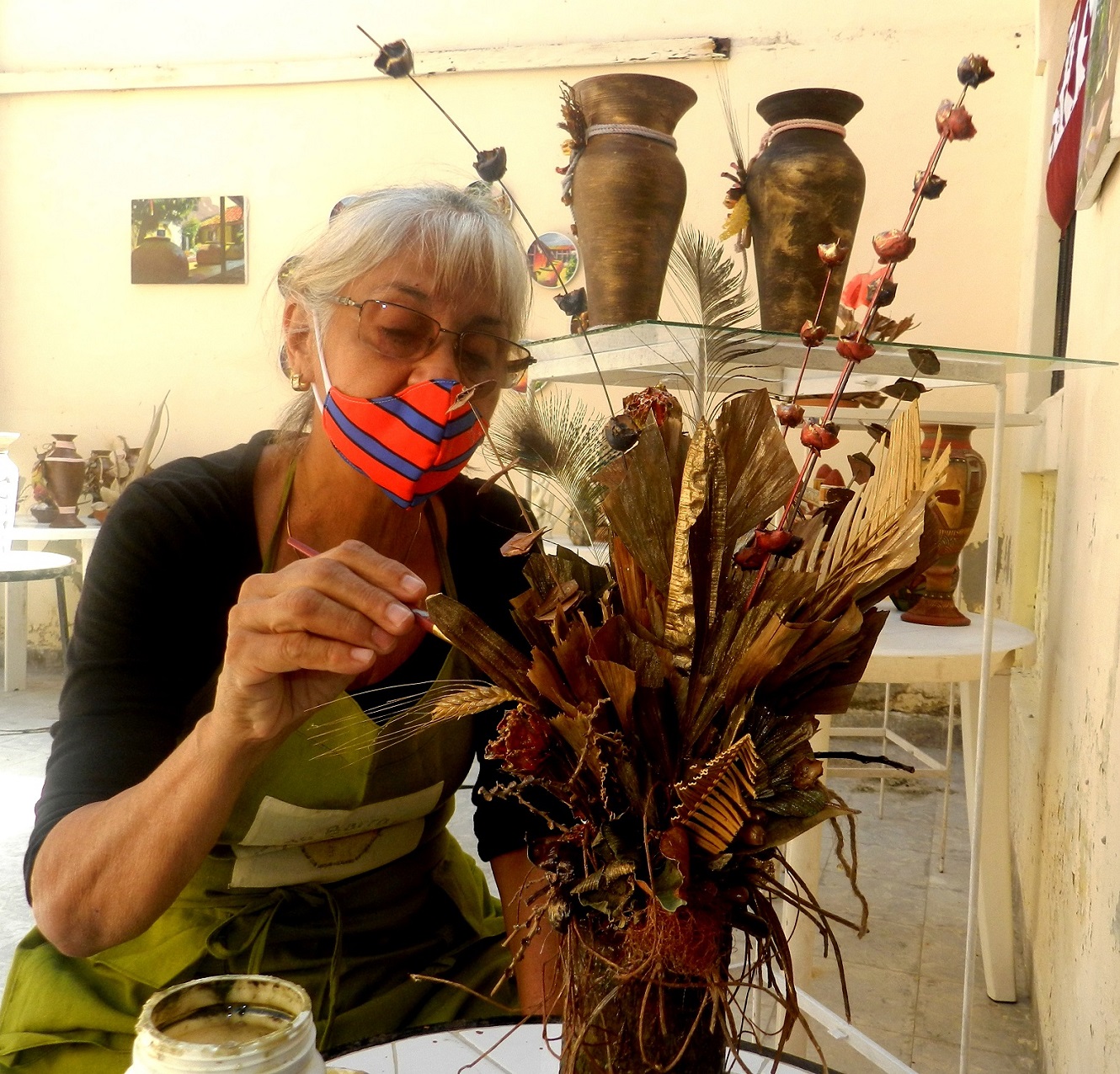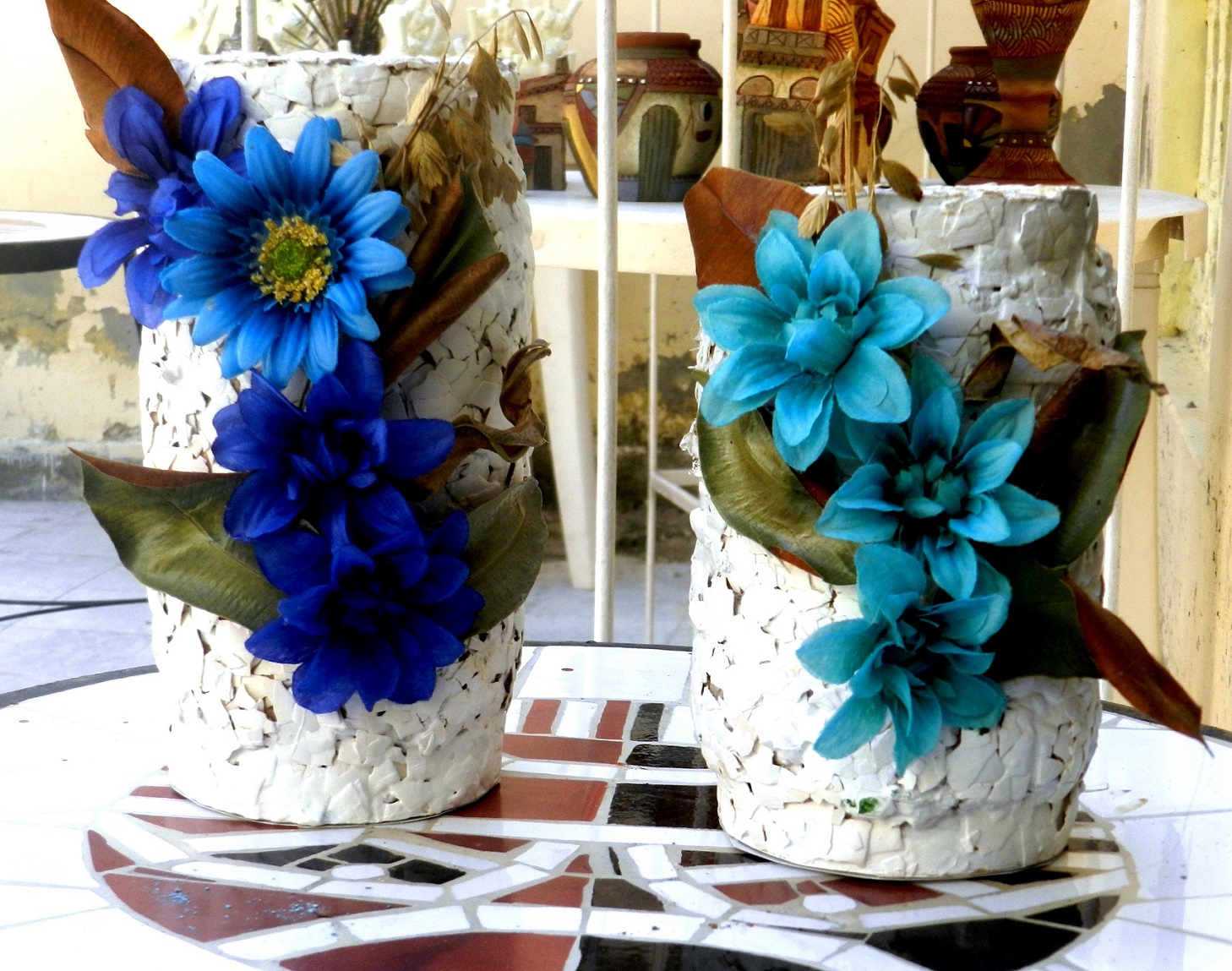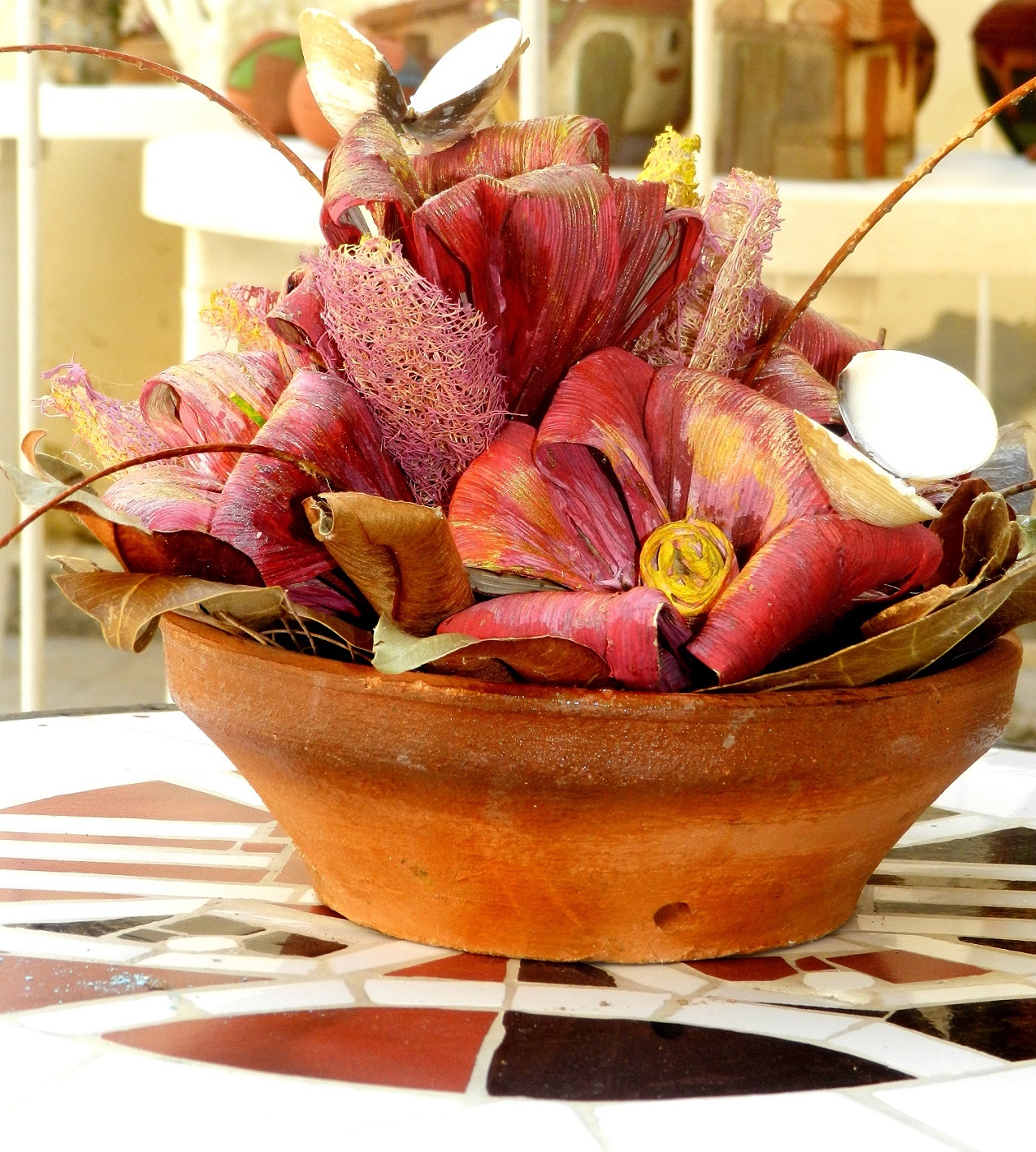 Revela la creadora que desde niña recogía las hojas y flores secas y las guardaba entre las páginas de sus libros para darles vida.
Revela la creadora que desde niña recogía las hojas y flores secas y las guardaba entre las páginas de sus libros para darles vida.
Texto y fotos
Lázaro David Najarro Pujol
Durante casi veinte años la artesana artista camagüeyana Addis Isabel Aguilar se dedica de forma sostenida a la recreación pictórica de objetos inanimados extraídos de la vida cotidiana (Naturaleza muerta), convirtiendo flores, frutas, semillas, vasijas, botellas, ramas de árboles, corales, conchas y hojas desechados en obras de arte. Es una defensora de la naturaleza y de los símbolos patrios que está presente en sus acciones.
Consta en la historia que los orígenes de la representación pictórica de objetos inanimados se remontan a las caracteres de «ofrendas de alimentos griegos, que se hallan generalmente en mosaicos griegos y romanos, con un fin decorativo; pero la naturaleza muerta apareció como género independiente recién en el Renacimiento, y en un principio fue considerado inferior en comparación al retrato o las alegorías».
Fue a partir de 2002 que Addis Isabel se interesó por este arte en la ciudad cubana de Camagüey, cuyo centro histórico es Patrimonio Cultural de la Humanidad. Ha participado en seis exposiciones personales y doce colectivas, entre las que sobresale el Salón Acalarre 2004, auspiciado por la filial camagüeyana de la Asociación Cubana de Artesanos Artistas (ACAA), evento en el que su proyecto alcanzó mención.
Revela la creadora que desde niña recogía las hojas y flores secas y las guardaba entre las páginas de sus libros para darles vida. «Me dolía mucho verlas descomponerse en el suelo o que las tiraran. Posteriormente, ya adulta, mi hijo que es ceramista, me informó que se impartiría un curso sobre Naturaleza muerta en la sede de los artesanos e inmediatamente me incorporé».
Añadió que existe disímiles formas de la Naturaleza muerta: prensada y seca en cuartos oscuros para luego trabajar en cuadros y en adornos florales, entre otras maneras. «Es para mí volver a darle vida a algo que está muerto. En mis manos retorna a la vida», aseguró a la Unión de Escritores y Artistas de Cuba.
Como consecuencia de su consagración y calidad de su labor en ese arte pictórico en el que convergen el diseño, el cromatismo y la iluminación («para producir un efecto de serenidad, bienestar y armonía»), en 2003 obtuvo premio en el Concurso de Artes Manuales «Amor y manos», que organizó la Oficina del Historiador de la Ciudad de Camagüey.
Addis Isabel es miembro del Proyecto Colibrí de Arte Miniaturista, adjunto a la Sociedad José Martí, en la suave comarca de pastores y sombreros, bajo la acertada, activa y entusiasta batuta de Nazario Salazar Martínez, convertido en un amplio movimiento que agrupa a más de un centenar de personas en toda la provincia.
Con habilidad y estética la artesana artista Addis Isabel Aguilar decora jarras de barro con semillas y otros elementos de la vida cotidianos. Defiende con convicción que «la naturaleza es bella y que todos la debemos cuidar».
 Fue a partir de 2002 que Addis Isabel se interesó por este arte en la ciudad cubana de Camagüey
Fue a partir de 2002 que Addis Isabel se interesó por este arte en la ciudad cubana de Camagüey Defiende con convicción que «la naturaleza es bella y que todos la debemos cuidar».
Defiende con convicción que «la naturaleza es bella y que todos la debemos cuidar».
Portafolio fotográfico con 21 instantáneas de la labor de esta artesana artista camagüeyana en FotoRevista de Argentina.
https://www.fotorevista.com.ar/Portfolios/21/210224231239/index.php
Addis Isabel Aguilar: the Cuban artist who gives life to the dead
March, 2021.-For almost twenty years, the artisan artist from Camagüey Addis Isabel Aguilar dedicates herself in a sustained way to the pictorial recreation of inanimate objects extracted from daily life (Still life), turning flowers, fruits, seeds, vessels, bottles, branches. of trees, corals, shells and leaves discarded in works of art. She is a defender of nature and the national symbols that are present in her actions.
It is recorded in history that the origins of the pictorial representation of inanimate objects go back to the characters of “Greek food offerings, which are generally found in Greek and Roman mosaics, with a decorative purpose; but still life appeared as an independent genre only in the Renaissance, and was initially considered inferior in comparison to portraiture or allegories ”.
It was from 2002 that Addis Isabel became interested in this art in the Cuban city of Camagüey, whose historic center is a World Heritage Site. She has participated in six personal exhibitions and twelve group exhibitions, among which the 2004 Acalarre Hall stands out, sponsored by the Camagüey branch of the Cuban Association of Artisan Artists (ACAA), an event in which her project achieved mention.
She reveals the creator who, since she was a child, collected dried leaves and flowers and kept them between the pages of her books to give them life. “It hurt me a lot to see them decompose on the ground or be thrown away. Later, as an adult, my son, who is a ceramist, informed me that a course on Still Life would be given at the artisans’ headquarters and I immediately joined ”.
She added that there are dissimilar forms of Still Life: pressed and dried in dark rooms to later work on paintings and floral ornaments, among other ways. “It is for me to bring something that is dead back to life. In my hands it comes back to life. ” she assured the national digital site of the Union of Writers and Artists of Cuba (UNEAC).
As a consequence of his consecration and quality of his work in this pictorial art in which design, chromaticism and lighting converge (“to produce an effect of serenity, well-being and harmony”), in 2003 he won a prize in the Arts Contest Manuals Love and Hands, organized by the Office of the Historian of the City of Camagüey.
Addis Isabel is a member of the Colibrí de Arte Miniaturista Project, attached to the José Martí Cultural Society, in the soft region of shepherds and hats, under the successful, active and enthusiastic baton of Nazario Salazar Martínez, which has become a broad movement that brings together more of a hundred people in the whole province.
With skill and aesthetics, the artisan artist Addis Isabel Aguilar decorates clay jugs with seeds and other elements of everyday life. She defends with conviction that “nature is beautiful and that we must all take care of it.” (Translated by Linet Acuña Quilez)
Con habilidad y estética la artesana artista Addis Isabel Aguilar decora jarras de barro con semillas y otros elementos de la vida cotidiana. Defiende la convicción de que “la naturaleza es bella y que todos la debemos cuidar”.
Leer más en https://www.radionuevitas.icrt.cu/cultura/7550-addis-isabel-aguilar-la-artista-cubana-que-le-da-vida-a-lo-muerto-fotos.html?fbclid=IwAR3asve0_DeA6NnyPqN2C0x3-lbD0Rjh2OFi1rFTg1oY_3xPa3hycJztsK4